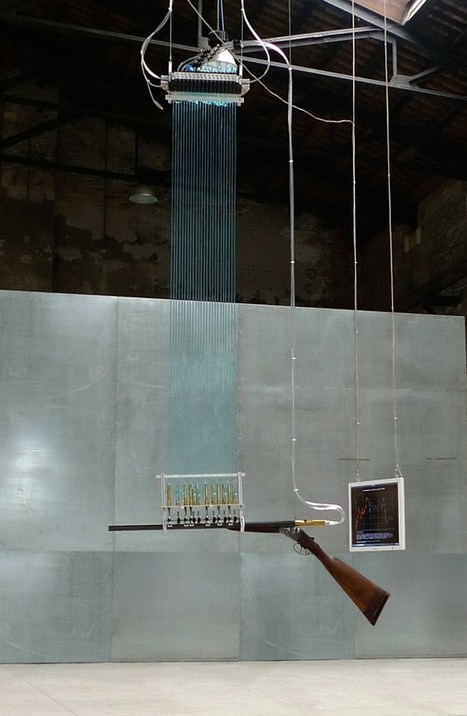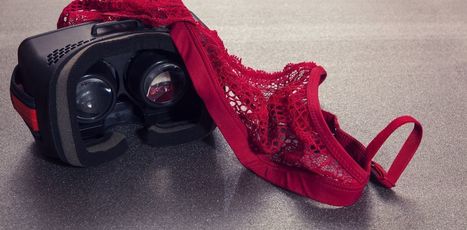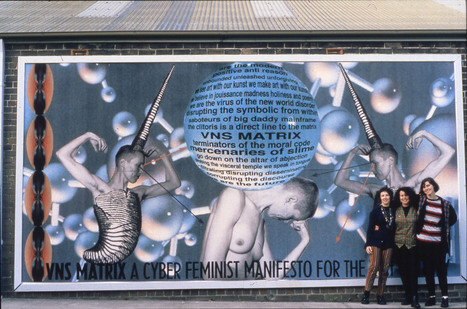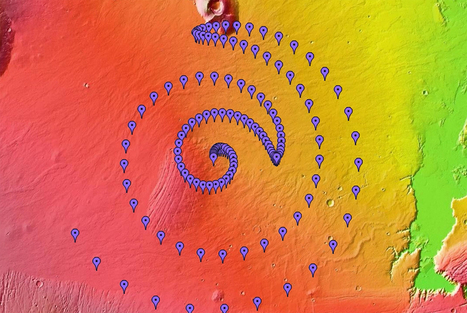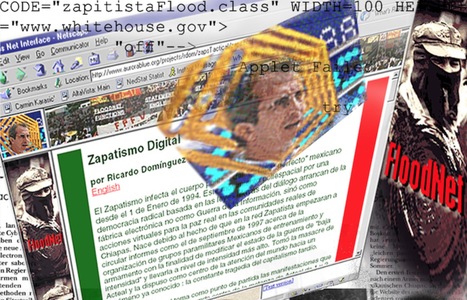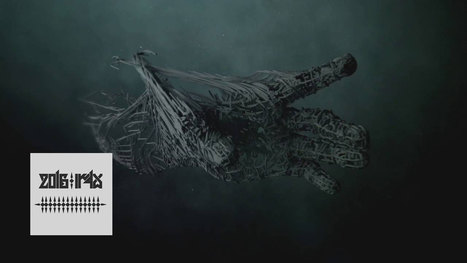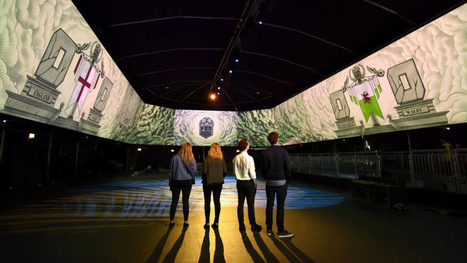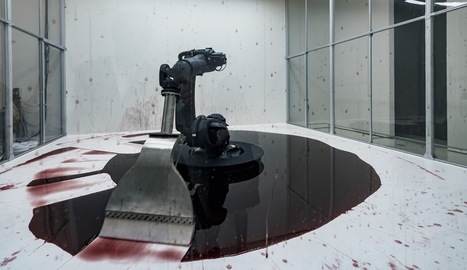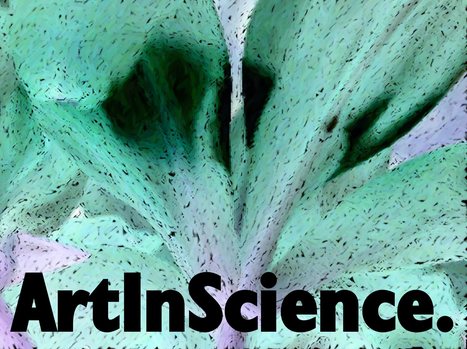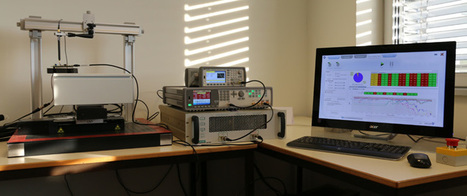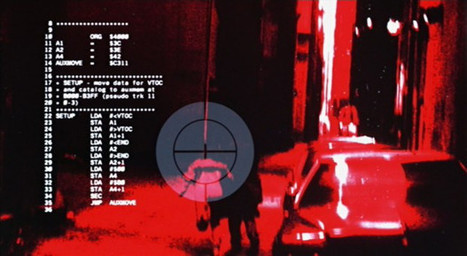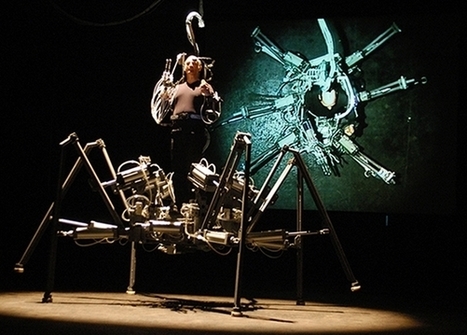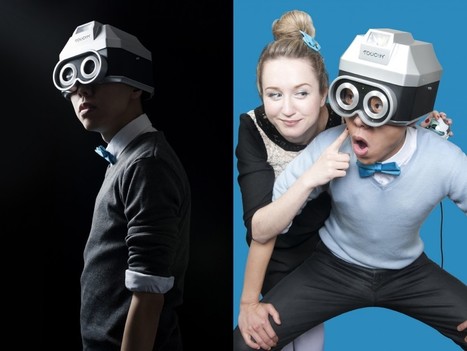 Your new post is loading...
 Your new post is loading...

|
Scooped by
Jacques Urbanska
January 30, 2017 3:54 AM
|
Si l’on parle quasiment toujours des lines-up de Peacock Society, on s’attarde plus rarement sur les acteurs des différentes scénographies numériques innovantes qui font de ce festival une expérience multi sensorielle, qualifié à juste titre de «festival des cultures électroniques (…) de la musique aux arts visuels». Ces scénographies révolutionnent notre façon de vivre, de penser et de ressentir la musique en mettant le spectateur au centre du processus créatif... ............... Une fois tous les deux mois, le mag Beat à l'air vous emmène à la découverte des meilleures scénographies immersives mêlant art sonore et visuel...
Diplômée d'un baccalauréat littéraire spécialité cinéma-audiovisuel et d'une option arts plastiques, Chloe Magdelaine suis actuellement en dernière année de licence "médiation culturelle et conception de projets culturels" spécialisée dans les arts visuels à la Sorbonne Nouvelle à Paris (FR) et écrit pour différentes revues...

|
Scooped by
Jacques Urbanska
January 10, 2017 5:57 PM
|
Have you heard people talking about machine learning but only have a fuzzy idea of what that means? Are you tired of nodding your way through conversations with co-workers? Let’s change that! This guide is for anyone who is curious about machine learning but has no idea where to start. I imagine there are a lot of people who tried reading the wikipedia article, got frustrated and gave up wishing someone would just give them a high-level explanation. That’s what this is. The goal is be accessible to anyone — which means that there’s a lot of generalizations. But who cares? If this gets anyone more interested in ML, then mission accomplished. What is machine learning?Machine learning is the idea that there are generic algorithms that can tell you something interesting about a set of data without you having to write any custom code specific to the problem. Instead of writing code, you feed data to the generic algorithm and it builds its own logic based on the data. For example, one kind of algorithm is a classification algorithm. It can put data into different groups. The same classification algorithm used to recognize handwritten numbers could also be used to classify emails into spam and not-spam without changing a line of code. It’s the same algorithm but it’s fed different training data so it comes up with different classification logic... Machine Learning is Fun! Part 2, Part 3, Part 4, Part 5 and Part 6

|
Scooped by
Jacques Urbanska
January 10, 2017 2:26 PM
|
The Last Gun is a mechano-robotic flute built out of a disabled shotgun and salvaged industrial components. The gun barrels have been transformed into a double-flute, which is played by compressed air. The mechanics are programmed and controlled through open-source electronics using an Arduino microprocessor and a Raspberry Pi board. The installation graphically charts and then musically depicts the rise & fall of annual U.S. arms exports. The flute’s aural response is based upon a value judgment. It is programmed to play a somber melody for every rise in arms exports and an upbeat tune for every year the arms exports drop.

|
Scooped by
Jacques Urbanska
January 10, 2017 4:02 AM
|
If you find your partner having a virtual relationship with someone else – or with a computer-generated individual – is that the same as adultery? July 2015 might well be known as the month online infidelity went public. This date coincided with one of the biggest and most revealing hacks in history when the Ashley Madison database was compromised and made available online. Ashley Madison, a dating website targeted at people already married or in relationships, had more than 36 million subscribers, 86% of whom were men. Just over one year later, and immersive technologies like virtual reality (VR) and augmented reality (AR) are on course to become mainstream. But what happens when online infidelity and virtual reality collide?

|
Scooped by
Jacques Urbanska
December 30, 2016 8:18 AM
|
Six months ago, I wrote some thoughts on the paradigm shift in how museums think about the balance between preserving an artwork and sharing it with the public. My conclusion was this: time-based media art installations do not truly exist until they are installed and, thus, these works must be exhibited — or “exercised” — with a certain degree of regularity. This is a concept first championed in the conservation field over a decade ago, by Pip Laurenson of Tate. Lovers, by Japanese media artist Teiji Furuhashi(1960–1995), is an excellent example of this. What follows is the story of how our team rescued this important example of early-1990s Japanese media art from a crumbling foundation of obsolete technologies (MS-DOS and LaserDisc, for starters) and ensured that it will live on so that generations long into the future are able to discover and enjoy it. In museums, where the work of the conservator is often dictated by what is scheduled for exhibition, it is unusual to have the opportunity to conduct in-depth research or conservation treatments on collection works that are not slated to appear in the galleries. There is, however, a rich tradition at The Museum of Modern Art of offsetting this trend through collaborations with academics and researchers. Through this, we are often able to build small-scale research projects that give students incredible real-world experience — and afford museum conservators the sort of research we wish we had more time for...

|
Scooped by
Jacques Urbanska
December 27, 2016 10:09 AM
|
A Cyberfeminist Manifesto for the 21st Century was a project in multiple media that gave vivid expression to the emerging political position of cyberfeminism, which saw new technology as an opportunity to disrupt society’s patriarchal norms, and to have fun doing it. The manifesto was authored in a mode that spoke to the conditions of early network culture: collaborative, plagiaristic, possibly drug-fueled, and pornographic. The resulting text was distributed by fax, snail mail, paste-up poster, billboard, and online post, adopting the techniques of propaganda as an art practice. Through its circulation, it began to generate new versions, spinoffs, and critiques, giving rise to new worlds for artists and theorists to inhabit...

|
Scooped by
Jacques Urbanska
December 27, 2016 8:00 AM
|
The Stedelijk Museum Amsterdam and MOTI in Breda are jointly acquiring 17 top digital works by contemporary artists in the Netherlands and abroad who are among the pioneers of digital art. This collaboration is spurred by MOTI’s change of course: it is due to reopen in the course of 2017 as the Stedelijk Museum Breda, where the legacy of the city of Breda will have a more prominent role.
In the short space of time that it existed, and under the management of Mieke Gerritzen, MOTI – founded in 2011 – has managed to build a remarkable collection of digital works by leading artists. The joint acquisition with the Stedelijk Museum Amsterdam means investing in a national collection in the field of digital art. This merging of curatorial vision transcends local museum policy. The course taken by MOTI in the collection of digital art coheres perfectly with the policy of the Stedelijk Museum Amsterdam, which is always geared to new forms of art with a particular interest in the cross-over between graphic design and visual arts.

|
Scooped by
Jacques Urbanska
December 27, 2016 7:28 AM
|
Ars investigates the nascent domain of turning source code and errors into art. Glitch art resonates with the increasingly complex love-hate relationship humans have with technology. Errors, and by extension the changes, that can occur within software source code and data can provide a fertile foundation for the imagination. In an attempt to explain this nascent artform, Martino Prendini wrote: “The error becomes image and movement, system errors are exploited, and it has a certain punk nature. At the same time, this kind of art exploits the glitch and uses it, so its nature is also entropic, dadaist... Glitch art is therefore the contradictory relationship between man and machine losing his functionality." ...

|
Scooped by
Jacques Urbanska
December 4, 2016 12:47 PM
|
This two-year online exhibition will present 100 artworks from net art history, restaging and contextualizing one project each week. Devised in concert with Rhizome's acclaimed digital preservation department, Net Art Anthology also aims to address the shortage of historical perspectives on a field in which even the most prominent artworks are often inaccessible. The series takes on the complex task of identifying, preserving, and presenting exemplary works in a field characterized by broad participation, diverse practices, promiscuous collaboration, and rapidly shifting formal and aesthetic standards, sketching a possible net art canon.

|
Scooped by
Jacques Urbanska
December 4, 2016 12:25 PM
|
It’s lunchtime in Diego Garcia and still dark in the Mid-Atlantic, but the first light of day is reflecting hard white off the former Google facility in Hamina, Finland. The cameras on BLIX and RITTER, the twin UNDATA satellites I'm flying over Europe’s Eastern border, trigger automatically. My shift’s first images appear on the monitor, overlays shimmering to life atop the decommissioned data center, outlining stacks of disassembled routers and cooling vents. The progress bar on the ops room’s jumbotron starts to fill. All green so far. The threat graph is bottomed-out today; the Finns have tightened up border security following several incursions by FSB and Spetssvyaz looters. But everything that was there yesterday is still there today. I take a moment to examine the traffic: dumper trucks heading towards Russia and the M10, the usual overnight flights nosing down from North America, the expected chatter in the ionosphere. Nothing to see here. The overview moves toward the Baltic States before swinging back up again, towards Sweden and the old Facebook plant. ... Personal data is anything but personal. Our phones and televisions listen in on us; the most powerful corporations in the world trade in consumer tics, browsing histories, and demographic identities. James Bridle is an artist and technologist whose work addresses issues of privacy, surveillance, and security; he coined the term "New Aesthetic" to describe the way the visual language of technology has begun to seep into the physical world. This is his first work of fiction. -The Eds

|
Scooped by
Jacques Urbanska
November 23, 2016 9:28 AM
|
In a little over a week, the 6th edition of TADAEX festival (Tehran Annual Digital Art Exhibition) takes place at Mohsen Gallery in Tehran, Iran. It’s a strong manifestation of the digital scene in Tehran and the people who make it possible, it features Iranian digital artists as well as far reaching international network of collaborators thanks to an ongoing residency program with NODE Forum for Digital Arts. The initiative enables joint projects of one Iranian and one German artist who work together at both festivals; this year it will be Lilian Nejatpour and Simon Weckert. Similarly, the exchange with Ars Electronica Festival and the Austrian Cultural Forum brings Austrian Artists to Tehran and provides a platform for TADAEX and its ideas: Ali Panahi, the festival’s director gave a talk on current developments and this year’s edition edition at Ars Electronica Festival 2016. In addition, TADAEX programme also includes exchange artists from Brazil, France, Japan, Kuwait and the Netherlands.

|
Scooped by
Jacques Urbanska
November 23, 2016 5:09 AM
|
Art and technology. At first these disciplines may seem distant, their link dubious, and yet they share a rich history and today are increasingly intertwined. An example of the intricate relationship between the two would be the invention of photography at the beginning of the nineteenth century, a defining moment in the history of fine arts, which provided the impetus that pushed painting beyond figuration and would eventually become an art canon in its own right. Nowadays, various technological ventures are considered artworks. From light installations to websites, technology has established itself as both a diverse artistic medium and the subject of numerous works of art, and has come to enormously enrich the art world. A quick look at the beginning of relationship between art and tech emphasises the general positive aspects that have arisen from the union. The 1968 show Cybernetic Serendipity, first held at the Institute for Contemporary Art (ICA) in London, was a pioneer in the symbiosis of technology and art. An exhibition dedicated to cybernetic art, it highlighted the opportunities computers opened up for creative production, ranging from music to writing and the visual arts...

|
Scooped by
Jacques Urbanska
November 23, 2016 4:22 AM
|
Created by Moniker (Roel Wouters & Luna Maurer) and made in conjuction with We Are Data travelling installation, Clickclickclick.click reveals the browser events used to monitor our online behaviour. The website invites the visitor to play along, direct behaviour to unlock “achievements”. Ranging from how many times you click on a button to how fast you move on the page and even how fast is your clicking speed, with the narrator voice who draws conclusions about your character based on your mouse behaviour, the website demonstrates the amount of behavioural data that can be/and is collected today through online services and advertising...
|

|
Scooped by
Jacques Urbanska
January 30, 2017 3:39 AM
|
On a recent afternoon, Brad Troemel showed me an image of a sculpture that seemed beyond belief: seven hundred monarch butterflies stacked on a levitating magnetic pedestal. Troemel had devised the sculpture six months before, and listed it, for twelve hundred dollars, in his online art store, Ultra Violet Production House. The work looked catalogue-slick, but it didn’t actually exist; the image had been created in Photoshop. The buyer would receive the components to make the work, along with directions for assembling it and a certificate of authenticity. Then she would build it herself, gluing on the butterflies one at a time. Troemel had calculated that the butterflies would weigh about thirteen

|
Scooped by
Jacques Urbanska
January 10, 2017 3:50 PM
|
Par définition, la logique du fou échappe à l'entendement de celui qui ne l'est pas. Ainsi, comment appréhender les troubles psychiatriques (hallucinations, paranoïa, confusion...) d'une personne atteinte de schizophrénie ? Voilà un défi parfois très perturbant pour l'entourage des personnes malades, qu'il s'agisse de la famille, des amis, des collègues ou même des soignants. Pour tenter de sensibiliser au vécu d'une personne atteinte de schizophrénie, le laboratoire Janssen a développé une application de réalité virtuelle (VR) qui propose de se glisser dans la peau d'un schizophrène. En enfilant un casque de VR Oculus rift, le "spectateur" est immergé à la première personne dans un scénario qui suit un malade sujet à des hallucinations auditives et des sentiments paranoïaques...

|
Scooped by
Jacques Urbanska
January 10, 2017 12:58 PM
|
Dans le cyberespace, personne ne vous entendra aimer… Rien de plus faux, avec l’adultère en ligne permis par la réalité virtuelle. Juin 2015 pourrait bien devenir le mois où l’infidélité en ligne a été révélée publiquement. Cette date coïncide en effet avec l’un des plus énormes et significatifs piratages de l’histoire, quand la base de données Ashley Madison a été victime d’une effraction et mise en ligne. Ashley Madison, un site de rencontres ciblé sur les gens mariés ou en couple, comptait plus de 36 millions d’abonnés, dont 86 % d’hommes. Moins d’un an plus tard, les technologies d’immersion comme la réalité virtuelle (RV) et la réalité augmentée (RA) se généralisaient. Alors, que se passe-t-il lorsque l’infidélité en ligne télescope la réalité virtuelle ?

|
Scooped by
Jacques Urbanska
January 8, 2017 5:35 PM
|
Projection Mapping Central is a community resource to learn about, promote and experience projection mapping. The website is curated by a handful of people researching projection mapping as PhD students. The website was created because we are frequently contacted by artists, marketing agencies, basketball teams and other random entities looking for projection mapping (spatial augmented reality) consulting. Unfortunately, as PhD students don’t have the time to aid in artistic or commercial endeavors. We started by compiling a list of projection mapping design firms, which turned into Projection Mapping Central. We invite the community to help make this the main resource for projection mapping.

|
Scooped by
Jacques Urbanska
December 30, 2016 7:59 AM
|
An enormous robotic arm, brandishing a giant squeegee, is poised over a pool of dark liquid which ceaselessly oozes outwards. With quick, smooth, aggressive movements, the machine performs a calculated dance, pivoting and dragging its squeegee across the surface in a perpetual labor of wiping the liquid back to the center. Can’t Help Myself, presented in the new exhibition Tales of Our Time, is an imposing installation by artists Sun Yuan and Peng Yu which holds the title as the Guggenheim’s first robotic artwork.
But robotic art is nothing new—so why did the museum wait until now to acquire a piece?

|
Scooped by
Jacques Urbanska
December 27, 2016 8:07 AM
|
Studio de création contemporaine unique en France, Le Fresnoy nous propose de découvrir tous les ans, au sein même de l’école, un « Panorama » – scénographié ici par Christophe Boulanger – d’une cinquantaine d’œuvres cinématographiques et d’installations multimédias, conçues au cours de l’année précédente par ses étudiants résidents et professeurs intervenants. Jusqu’au 31 décembre l’école, fondée et dirigée par Alain Fleischer à Tourcoing, reste ouverte pour une monstration qui rend compte des questionnements d’artistes issus des quatre coins du monde autant que de la diversité des propositions formelles qui les sous-tendent. Quatre projets nous ont particulièrement inspirés, qu’ils relèvent d’une production interdisciplinaire et/ou d’une économie de moyens, concentrée autour de la restitution d’une parole ou d’une idée originale, faisant disparaître la technologie au profit d’une main divine… (ou d’un esprit malin)...

|
Scooped by
Jacques Urbanska
December 27, 2016 7:49 AM
|
What We Do - Arts-based science communications
- Fund public Art-Inspired-By-Science exhibitions and networking events Connect curators, artists, and scientists
- exploring collaborations Share #artsci #sciart news, trends, and funding opportunities
About the Founder Bob Nidever is a composer, organizer of the 7,000 plus members International Scientist Artist Collaborations group on LinkedIn, and has a distinguished career in academia commercializing scientific discoveries.

|
Scooped by
Jacques Urbanska
December 6, 2016 2:11 AM
|
Quand on parle de sécurité informatique, la plupart des gens pensent aux mathématiques et à la cryptographie au sens logique théorique, mais peu pensent à la physique. Or dans la physique se cachent actuellement de nombreuses failles de sécurité, extrêmement difficiles à anticiper. Commençons par une simple énigme. Une pièce contient une ampoule éteinte, vous êtes à l'extérieur de cette pièce avec trois interrupteurs sur position « off ». Vous pouvez manipuler comme vous le souhaitez les interrupteurs mais vous ne pouvez entrer qu'une seule fois dans la pièce. Comment déterminer quel interrupteur allume l'ampoule ?

|
Scooped by
Jacques Urbanska
December 4, 2016 12:43 PM
|
Anders Hoff is a generative artist and programmer. Most of his time is spent exploring the interesting results you can get from simple rules.

|
Scooped by
Jacques Urbanska
November 25, 2016 6:36 AM
|
All right, don’t panic, but computers have created their own secret language and are probably talking about us right now. Well, that’s kind of an oversimplification, and the last part is just plain untrue. But there is a fascinating and existentially challenging development that Google’s AI researchers recently happened across. You may remember that back in September, Google announced that its Neural Machine Translation system had gone live. It uses deep learning to produce better, more natural translations between languages. Cool! Following on this success, GNMT’s creators were curious about something. If you teach the translation system to translate English to Korean and vice versa, and also English to Japanese and vice versa… could it translate Korean to Japanese, without resorting to English as a bridge between them? ...

|
Scooped by
Jacques Urbanska
November 23, 2016 6:50 AM
|
In 2007 the Australian performance artist Stelarc started growing an extra ear on his left arm through a series of operations that are still ongoing. The ear is actually made up of his own stem cells woven into a biodegradable frame. Eventually a Bluetooth device will be inserted and Stelarc will be able to hear and communicate through it. Stelarc’s work focuses on body enhancement, exploring the radical changes our bodies will undergo in the 21st century. He also created “Exoskeleton,” a 1,300-pound prosthetic machine with six legs driven by 18 pneumatic actuators. Stelarc climbs into the middle of this huge device and pilots it with arm gestures. It is a harbinger of how technology and humans will increasingly merge—a future in which cyborgs (or robotic machines) will be operated by our brains, while the rest of our bodies will become obsolète. ...

|
Scooped by
Jacques Urbanska
November 23, 2016 4:41 AM
|
Robotic art is a type of art that makes use of robotics or machine and automated technology, coupled with computer technology and sensors. Robotic art generally falls under the broader umbrella of kinetic art, which includes art that uses mechanical elements, such as motors, machines and electrically powered systems, but doesn’t necessarily include a computer programme. With the rise in electronic media and technology in art, robotics has become a popular medium of experimentation. Robotic art can be traced back through history to the first hydraulic sculptures while the genesis of contemporary robotic art can be pinpointed to the 1960s...
|



 Your new post is loading...
Your new post is loading...




